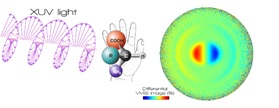|
Like any massive particle, photons may carry both a spin and an orbital angular momentum. The former is associated to the circular polarisation of a light beam, while the latter is associated to an helicoidal wavefront ( see for instance the review by A. M. Yao and M. J. Padgett). These two types of beams find applications in different situations. In particular, while the spin projection along the propagation axis for paraxial beams is limited to two values, |
 |
|
Transfer of orbital angular momentum A basis of light beams showing orbital angular momentum is the Laguerre Gaussian beams (see e.g. the presentation by .D. Dounas-Frazer. ). This leads to capabilities of much denser encoding of information on light beams. For spectroscopic and imaging outlooks in particular, having at hand XUV beams carrying orbital angular momentum would be invaluable. It is also an ideal situation to test conservation laws derived from quantum mechanics. We managed to transfer orbital angular momentum from a visible light beam to the XUV using the high harmonic generation process. These beams have an helicoidal wavefront associated to an azimuthal phase. The phase singularity in the center of the beam leads to a zero of intensity, explaining their “donut” shape. This is what is reported in the figure to the left. We could also measure their “topological charge” and verify the conservation law: harmonic q carries q times the orbital angular momentum of the driving laser. Finally, we could measure their spatio-temporal structure, showing a double helix pattern.  |
Through a collaboration with the group of Giovanni de Ninno , we could generalized this transfer law to the case of HHG with two beams. Funding : ANR Xstase coordinated by Thierry Ruchon People : Antoine Camper, Romain Géneaux, Céline Chappuis, Thierry Auguste, Thierry Ruchon Publications : Géneaux R et al., “Synthesis and characterization of attosecond light vortices in the extreme ultraviolet“, Nature Communications., Vol. 7, pp. 12583 (2016). Gauthier, D. et al., “Tunable orbital angular momentum in high-harmonic generation“, Nature Communications Vol. 8, 14971 (2017). See also the press release on the CEA website Géneaux et al. |
|
Transfer of spin Angular momentum Chiral molecules, which are molecules that cannot be superimposed to their mirror image (like the hands for instance), are ubiquitous in nature. Chirality is even sometimes proposed as a condition for the emergence of life. On more practical grounds, the two forms of a chiral chemical usually interact very differently with living organisms. The study of the dynamics of chiral molecules thus carries both fundamental and applied interests. However, we very poorly know their dynamics at the femtosecond time scale and below, which is due to a lack of adapted diagnosis tools. In a series of works coordinated by Yann Mairesse and Valérie Blanchet at CELIA-Bordeaux, we showed how a tuned HHG source could provide the perfect probe for these molecules, with femtosecond to attosecond time resolution. More precisely, tuning the polarization state of the driving laser, we managed to generate quasi circularly polarized harmonics. We used them to measure PhotoElectron Circular Dichroism (PECD) in a Velocity Map Imaging Spectrometer. This phenomenon, which is limited to chiral objects and depends on their chirality, has been largely studied on synchrotron quasi continuous sources ( Desirs com.). This first study was extended to all regime of photoionization (multiphoton, tunnel, direct), showing the universality of the phenomenon. More recently, carrying RABBIT-like experiments, we could measure a slight delay, as short as 7 as between electrons exiting a chiral molecule on one side or the other. |
This research was performed at CELIA-Bordeaux, in a collaboration between, the team of the DESIRS beamline on the SOLEIL synchrotron and the LCAR laboratory in Toulouse. See also the press release on the CNRS website Ferré et al. Funding on LIDYL side : ANR Xstase coordinated by Thierry Ruchon People from LIDYL : Romain Géneaux, Céline Chappuis, Thierry Ruchon Publications : “A table-top ultrashort light source in the extreme ultraviolet for circular dichroism experiments“ Ferré A et al., Nat Photon., Vol. 9(2), pp. 93-98. (2015). “Probing ultrafast dynamics of chiral molecules using time-resolved photoelectron circular dichroism“ Beaulieu S, et al., Faraday Discuss. Vol. 194, pp. 325. (2016). “Attosecond-resolved photoionization of chiral molecules“ Beaulieu S,et al., Science., Vol. 358(6368), pp. 1288, (2017).  |



